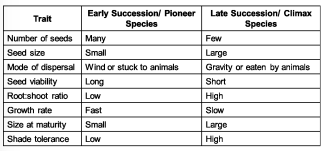
30: Community ecology--Succession
Succession: the process by which the species composition of a community changes over time
Seral stage: each stage of community change during the process of succession
Pioneer species: the earliest species to arrive at a site
Climax community: the final stage in the process of succession
Direct observations: measuring succession after a disturbance
Indirect observation: space for time approach
Cronosequence: a sequence of communities that exist over time at a given location
Primary succession: the development of communities in habitats that are initially devoid of plants and organic soil, such as sand dunes, lava flows, and bare rock
Secondary succession: the development of communities in habitats that have been disturbed and include no plants but still contain an organic soil
Complexity: communities might have a characteristic climax stage, but the stages to reach it might vary
Glacier Bay
Animal succession
mostly a respond to the plant succession
Succession in intertidal communities
Succession in Shallow Lakes and Ponds
Change in species diversity
Early vs. late-succession species
trade-offs between seed mass and seedling morality under high-shade conditions
 '
'
Facilitation: a mechanism of succession in which the presence of one species increases the probability that a second species can become established
Inhibition: a mechanism of succession in which one species decreases the probability that a second species will become established
Tolerance: a mechanism of succession in which the probability that a species can become established depends on its dispersal ability and its ability to persist under the physical conditions of the environment
Tests: intertidal community
Changes in climax communities over time
changes continue to occur
mature forest in Pennysylvania
Changes in climax communities over space
spatial heterogeneity
Transient climaxes:
vernal pools: water vs dry stages
creating gaps in a climax community
gaps open spaces for non-climax species
Community stability: the ability of a community to maintain a particular species composition
Community resistance: the amount that a community changes when acted upon by some disturbance, such as the addition or removal of a species
Community resilience: the ability of a community to return to its original state after being disturbed
Alternative stable states: when a community is disturbed so much that the species composition and relative abundance of populations in the community change, and the new community structure is resistant to further change
Alternative stables states in intertidal communities: brown rockweed algae is a dominant competitor, but disturbance allows other species to thrive
Succession: the process by which the species composition of a community changes over time
Seral stage: each stage of community change during the process of succession
Pioneer species: the earliest species to arrive at a site
Climax community: the final stage in the process of succession
Direct observations: measuring succession after a disturbance
Indirect observation: space for time approach
Cronosequence: a sequence of communities that exist over time at a given location
Primary succession: the development of communities in habitats that are initially devoid of plants and organic soil, such as sand dunes, lava flows, and bare rock
Secondary succession: the development of communities in habitats that have been disturbed and include no plants but still contain an organic soil
Complexity: communities might have a characteristic climax stage, but the stages to reach it might vary
Glacier Bay
Animal succession
mostly a respond to the plant succession
Succession in intertidal communities
Succession in Shallow Lakes and Ponds
Change in species diversity
Early vs. late-succession species
trade-offs between seed mass and seedling morality under high-shade conditions
 '
'
Facilitation: a mechanism of succession in which the presence of one species increases the probability that a second species can become established
Inhibition: a mechanism of succession in which one species decreases the probability that a second species will become established
Tolerance: a mechanism of succession in which the probability that a species can become established depends on its dispersal ability and its ability to persist under the physical conditions of the environment
Tests: intertidal community
Changes in climax communities over time
changes continue to occur
mature forest in Pennysylvania
Changes in climax communities over space
spatial heterogeneity
Transient climaxes:
vernal pools: water vs dry stages
creating gaps in a climax community
gaps open spaces for non-climax species
Community stability: the ability of a community to maintain a particular species composition
Community resistance: the amount that a community changes when acted upon by some disturbance, such as the addition or removal of a species
Community resilience: the ability of a community to return to its original state after being disturbed
Alternative stable states: when a community is disturbed so much that the species composition and relative abundance of populations in the community change, and the new community structure is resistant to further change
Alternative stables states in intertidal communities: brown rockweed algae is a dominant competitor, but disturbance allows other species to thrive